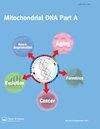咖啡针孔虫Xylosandrus compactus (Eichhoff)遗传特征及DNA条形码分析(鞘翅目:锥虫科:锥虫科)
IF 0.6
4区 生物学
Q4 GENETICS & HEREDITY
引用次数: 3
摘要
摘要虫科甲虫是世界上危害最大的昆虫。其中黑枝螟Xylosandrus compactus (Eichhoff)(鞘翅目:曲蝇科:鞘翅科)是咖啡种植园的严重害虫之一。它们在寄主植物内的隐秘生命周期使这些昆虫难以控制。对其进行有效管理,准确、及时、快速的物种鉴定至关重要。通过对该甲虫5'线粒体细胞色素氧化酶c亚基1 (COI)基因的克隆和测序,证实了其分子鉴定为X. compactus。分析的核苷酸序列中未发现假基因和假序列;它们在核苷酸NCBI基本局部比对搜索工具中具有较高的匹配度。该基因序列保存在NCBI GenBank, accession number为KY172634、KY172635, Barcode of Life (BOLD), BIN ID为ACB4177。在此基础上,基于多序列比对,绘制了具有最大概率的系统发育树。在NCBI GenBank数据库中收集到的不同地理区域的物种数据与紧实X. compactus物种聚类一致。空间和时间采集的咖啡孔螟在形态和分子上没有差异,因此所描述的所有标本都是既侵染罗布斯塔咖啡又侵染阿拉比卡咖啡的紧凑X. compactus。本文章由计算机程序翻译,如有差异,请以英文原文为准。
Genetic characterization and DNA barcoding of coffee shot-hole borer, Xylosandrus compactus (Eichhoff) (Coleoptera: Curculionidae: Scolytinae)
Abstract Beetles of the subfamily Scolytinae are the most damaging insects in the world. Among which the black twig borer, Xylosandrus compactus (Eichhoff) (Coleoptera: Curculionidae: Scolytinae), is one of the serious pests in coffee plantations. Their cryptic life cycle inside the host plant makes these insects difficult to control. For its effective management accurate, timely and rapid identification of species is critical. By cloning and sequencing the 5' mitochondrial cytochrome oxidase c subunit 1 (COI) gene, the beetle’s molecular identification confirmed its identity as X. compactus. No pseudogenes and indels were found in analyzed nucleotide sequences; they match with high similarity in nucleotide NCBI Basic Local Alignment Search Tool search. The X. compactus COI genes sequences were deposited at NCBI GenBank with accession numbers of KY172634, KY172635 and the Barcode of Life (BOLD) with BIN ID: ACB4177. Furthermore, based on multiple sequence alignment of the X. compactus MtCOI gene, a phylogenetic tree with maximum probability was drawn. X. compactus species clustered together which agree with the species data collected from NCBI GenBank database from the different geographic regions. There were no morphological and molecular differences between space and time—collected coffee shot—hole borers, thus all the specimens described were X. compactus infesting both robusta and arabica coffee.
求助全文
通过发布文献求助,成功后即可免费获取论文全文。
去求助
来源期刊

Mitochondrial Dna Part a
Biochemistry, Genetics and Molecular Biology-Genetics
CiteScore
3.00
自引率
0.00%
发文量
6
期刊介绍:
Mitochondrial DNA Part A publishes original high-quality manuscripts on physical, chemical, and biochemical aspects of mtDNA and proteins involved in mtDNA metabolism, and/or interactions. Manuscripts on cytosolic and extracellular mtDNA, and on dysfunction caused by alterations in mtDNA integrity as well as methodological papers detailing novel approaches for mtDNA manipulation in vitro and in vivo are welcome. Descriptive papers on DNA sequences from mitochondrial genomes, and also analytical papers in the areas of population genetics, phylogenetics and human evolution that use mitochondrial DNA as a source of evidence for studies will be considered for publication. The Journal also considers manuscripts that examine population genetic and systematic theory that specifically address the use of mitochondrial DNA sequences, as well as papers that discuss the utility of mitochondrial DNA information in medical studies and in human evolutionary biology.
 求助内容:
求助内容: 应助结果提醒方式:
应助结果提醒方式:


